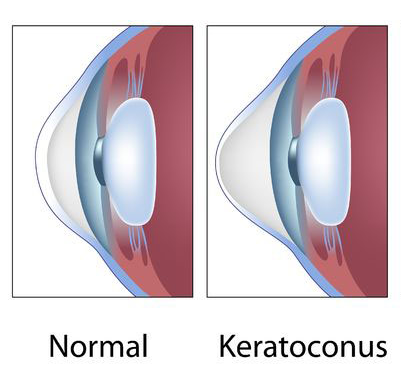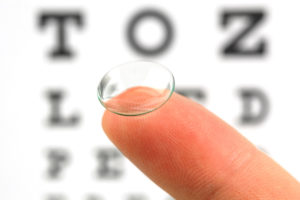If you suffer from keratoconus, there is financial help available.
What is keratoconus?
Keratoconus: progressive thinning and distortion of the cornea causing reduced vision.
The cornea is the window of the eye. Light travels through the cornea past the lens to the retina and then the brain to form a visual image. A normal, healthy cornea holds its round shape. However, someti mes the cornea becomes structurally weakened and loses its shape. Instead of a dome, the cornea becomes cone shaped and the surface irregular. This prevents the light entering your eye from being focused correctly on the retina, so a distorted image is projected onto the brain.
mes the cornea becomes structurally weakened and loses its shape. Instead of a dome, the cornea becomes cone shaped and the surface irregular. This prevents the light entering your eye from being focused correctly on the retina, so a distorted image is projected onto the brain.
What are the symptoms of keratoconus?
Common symptoms include:
- ghosting
- increased sensitivity to light
- multiple images
- glare at night
- halos
- starbursts around lights
- blurred vision
- frequent prescription changes in glasses and contact lenses
What causes keratoconus?
This is a question that optometrists have been looking into for a long time and as yet, we don’t actually know the answer. However, even though the cause of keratoconus is unclear, we do know that there is a strong link to allergies and eczema, as well as eye rubbing, and quite probably a genetic component.
The condition usually happens in the late teens to early twenties; however, it can be present at any age. It is a progressive disorder and can happen rapidly or take years to develop. It usually affects both eyes, although sometimes only one eye is affected.
Keratoconus treatment. What can we do about it?
If you think you may have keratoconus, the first thing you need to do is see one of our optometrists who will do a corneal topography to determine whether the cornea shows any abnormalities.
If keratoconus or another corneal disorder is spotted, we will then look at all the options available to you.
Contact lenses
In the early stages, or with mild cases of keratoconus, glasses or soft contact lenses may be enough to correct your vision. However, as the disorder progresses, and the cornea becomes increasingly distorted, specially designed soft lenses can help. In more advanced keratoconus, rigid custom-made gas permeable contact lenses (RGP) are usually the best option. These are designed so that the front curve is spherical (to provide undistorted vision) but the back curves are tailored so the lens stays on the irregular cornea.
 The best lens is the one that fits your eye, corrects your vision and is comfortable to wear.
The best lens is the one that fits your eye, corrects your vision and is comfortable to wear.
The process of fitting a keratoconic eye is highly specialised and can take several months to get everything perfect so that you have you the safest, clearest vision fit for driving, work and study.
Keratoconus subsidy for contact lenses
In New Zealand, the Ministry of Health provides a keratoconus subsidy: a contact lens subsidy for eligible patients who are unable to have their vision corrected by spectacles. The keratoconus subsidy assists in the payment of your eye examination, contact lens fitting and the contact lenses themselves.
Although it generally doesn’t cover all the costs, the keratoconus subsidy will significantly lower the cost for you. The keratoconus subsidy is managed between our optometrists and the MOH (Ministry of Health), so our optometrists can make the application on your behalf.
For those patients who are entitled to it, further assistance to cover the patient part charge may also be available from WINZ.
Keeping an eye on your health
Regular eye examinations are vital. They ensure your eye doctor has a chance to detect conditions like keratoconus before they become a bigger problem. Our optometrists recommend once-a-year eye health checks. Full eye exams start from $65 and you can get an eye test at either our Newmarket or Henderson optometry practice.
Call 09 522 1283 or 09 836 1731 to book an appointment with an optometrist.

